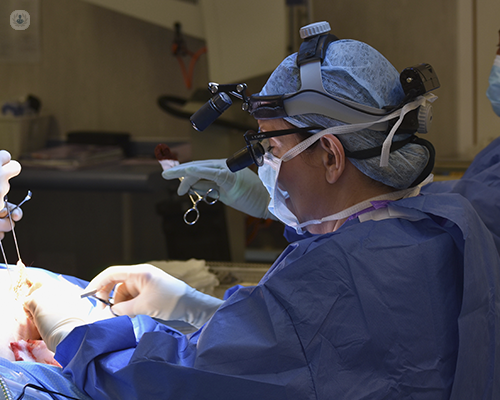Facial paralysis surgery
Autore:Facial paralysis is the inability to move your face due to nerve damage. It can be life-changing, but fortunately, there are surgical treatments available to try and recover some facial movement. By reading this explanation by Ms Tzafetta, an aesthetic and reconstructive plastic surgeon, you’ll have a thorough understanding of facial paralysis and its surgical treatment.

What is facial paralysis?
Facial paralysis is the result of an injury to the facial nerve. Patients with this injury are not able to move the affected side of the face, and the affected side will be pulled to the fully functioning side. Someone with facial paralysis will show the following symptoms:
- Droopiness of the eyebrow
- Unable to close their eye(s)
- Reduced rate or lack of blinking
- A corner of their mouth is droopy
- A loss of oral continence (drooling). In this case, speech and eating can be affected.
- All of these symptoms can have a negative effect on the patient’s psychology, and they will possibly need psychological support.
What causes facial paralysis?
The commonest reason is Bell’s palsy, a progressive condition. The cause is unclear, but it is believed to be caused by swelling of the facial nerve in the cranial bone, resulting in nerve compression and consequently, Bell’s palsy. Other causes are
- Viral infections (e.g. zoster herpes at the acoustic canal)
- Trauma
- Tumours involving the nerve or the neighbouring area
- Damage to the nerve during surgery
In addition, some people are born with facial paralysis (sometimes affecting both sides of the face). The paralysis can be partial, not involving the full side of the face, or complete with all the hemiface been completely paralyzed.
How long does it usually last? Can it return?
Depending on the cause, facial paralysis can improve within three to six months. About 80% of patients with Bell’s palsy will be almost fully recovered within six months. Treatment with steroids for about two weeks as soon as the paralysis happens has been proven to help with recovery.
When a nerve is cut and not repaired, the paralysis will be permanent. However, there are also instances in that the facial nerve is preserved. In the 20% of Bell’s palsy patients who don’t fully recover within six months and the ones with nerve damage, operative procedures are indicated to restore movement and function on the face.
What are the surgical treatment options for facial paralysis?
There are different types of operations depending on the problem associated with the patient’s facial paralysis. We always give priority to the eye’s ability to fully close and to protecting the eye.
We can perform a repositioning of the lower eyelid. When doing so, the lid is pulled upward, and we often apply platinum or gold weight to the upper eyelid to achieve better eye closure. For the restoration of the smile and cheek balance, techniques such as nerve repairs or transfers, and either regional or distant muscles transfers are performed to restore function. Another area that attention is paid to is the lower lip movement and techniques involving nerve and muscle transfers are also applicable for this area too.
Facial paralysis surgery: what can I expect?
The techniques used to give movement back to the face are often complex reconstructive procedures. Although some improvement can be seen from the beginning, in most cases movement of the face starts to become noticeable from four to six months after the operation. It can take as long as two years or more to see the final outcome of the surgery.
Physiotherapy is an integral part of the treatment. Furthermore, Botox can address issues related to facial asymmetry and facial spasticity (synkinesis) that can happen after facial nerve function recovery. Massaging of the face and facial exercises with the use of a mirror are also advisable for the rehabilitation process.
Will surgery stop it from happening again?
In a small group of patients, it has been noted that paralysis can happen again in the same or opposite side of the face. Although surgery will not stop it from happening again, depending on what type of reconstruction has taken place, it may mask the recurrence of the paralysis if it does happen again.
Ms Tzafetta is a highly trained expert in the treatment of facial paralysis, among other surgical procedures. Visit her profile to see how she can help you and to book a consultation.


